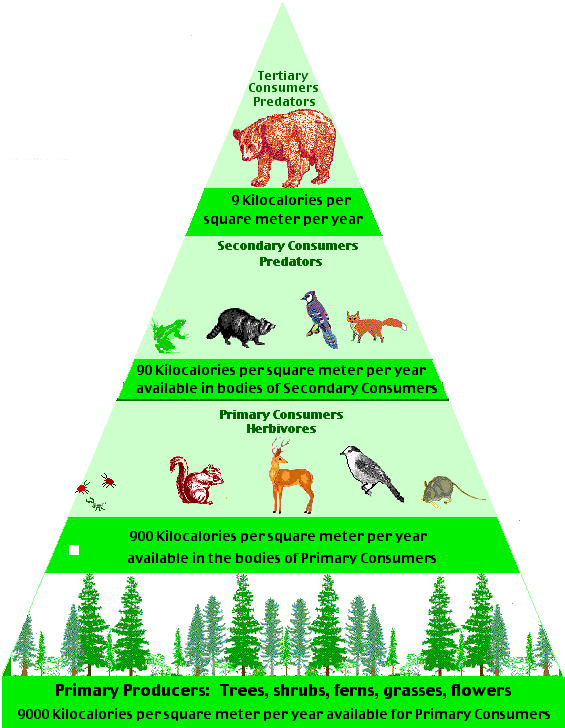-
Chapter 13:ORGANISMS AND ENVIRONMENT
Introduction
Ecology – study of relationship between organisms and environment
Ecosystems – functional unit of nature encompassing interaction between its biotic and abiotic components.
Habitat – surrounding where organisms live. It has abiotic components like rocks, soil, air, water and light. It also has biotic components like plants, micro organisms, animals. 70% of all species are animals [out of 10 animals 7 are insects] and 22% are plants.
Food
chain - a series of organisms feeding on each other
taking part at various biotic levels. Each step of the
food chain is called trophic level. At each
trophic level, 10% of the energy present is passed on to
the higher trophic level. [10% law] i.e. from
plants to herbivores to carnivores.
Transfer
of energy in trophic levels is unidirectional. The pyramid
of trophic levels shows sharp decline from bottom to top.
Living organisms are classified into 5 broad kingdoms: Monera, Protista, fungi, plantae, and animalia.

Fig 1: Biomass Pyramid
However the aquatic biomass pyramid is inverted. A small mass of phytoplankton support a large mass of zooplanktons.

Fig 2: Aquatic ecosystem - Inverted biomass pyramid
Since at each level organisms are eaten by several other organisms at higher level, we use food webs to depict these.
Bio-magnification
is phenomenon when harmful substances absorbed by lower
level are passed on to higher trophic levels. However at
higher trophic levels, the concentration of these
substances increases [magnifies] as these feed on large
number of organisms from lower trophic levels.
Eutrophication is the natural aging of the river or water body due to nutrient enrichment. Acceleration of this happens when manmade activities release pollutants in the lakes. This affects aquatic life and increases growth of water hyacinth [most problematic weed]. The lake literally chokes to death.
Bio fortification is breeding crops with higher levels of vitamins and minerals.
Bio remediation is use of microbes to make toxic waste harmless.
Mega biodiversity regions
Mega
biodiversity region is the region between tropic of cancer
and Capricorn. This is since the tropical areas have been
undisturbed for a long time enough for species
diversification also more solar energy is available and
temperature is constant and predictable. Half the world’s
biodiversity is located in few countries like Brazil,
India, Columbia, equator, Peru, Indonesia, Zaire,
Madagascar, China and Malaysia.
Acclimatization
Acclimatization: Small but rapid changes taking place in a single organism to overcome changes in thesurrounding. When we reach high altitudes, due to low pressure body doesn’t get enough oxygen and this is countered by increasing breathing rate, RBC count inblood and reducing binding affinity of hemoglobin.
e.g.: when we move from plains to mountains we breathe faster.
Camels have long legs to keep body away from the heat of the ground. They don’t sweat, their dung is dry and urine is very less.
Fishes
have streamlined body and fins to help move and
change direction in water. They have scales on skin to
protect the body and help in easy movement. Gills help
them use oxygen dissolved in water.
Aquatic
animals use the carbonates dissolved in sea water
to make their shells. This is another reason why CO2 is
less in the atmosphere.
As oxygen dissolved in water is less, aquatic animals breathe faster than terrestrial. However as temperature decreases oxygen solubility in water increases, thus aquatic animals are more comfortable in cold waters than warm.
Scuba divers have a lower concentration of nitrogen and higher conc. of oxygen and helium in the breathing tank as under pressure of sea the other atmospheric gases dissolve more in blood. When the diver comes to shore, this pressure decreases and dissolved gases are released. This would create bubbles in blood vessels.
Polar
bears have two thick fur layers under their skin and
a layer of fat that insulates them from cold.
Small
animals are rarely found in cold areas as they might lose
body heat quickly due to the larger surface area relative
to the volume.
In deep oceans we find brown algae as only certain components of visible light can penetrate depth of sea.
Desert plants like cactus don’t have leaves but spines. They loose very little water by transpiration. Photosynthesis is carried out in the stems. CAM pathway is a special photosynthesis mechanism which keeps stomata closed during it. They have very long roots.Mountain plants might have cone shaped structure with sloping branches or needle like leaves. The rainwater or snow slides off easily. Animals in such areas have thick skins or fur.
Some
birds, fish even insects migrate seasonally to
more hospitable regions.
Animals
in tropical rainforests see intense competition
over food.
Plants lack nervous system or muscles.
Photochemical smog is formed due to peroxyacetyl nitrate, hydrocarbons, ozone, nitric oxide, formaldehyde and sunlight. It is called oxidizing smog. To solve this we could plant pinus, junipirus, and pyrus as they metabolize NO2.
To increase CO2 solubility in soft drinks, the bottle is sealed under high pressure.
Official YouTube Channel of UPSCFEVER - #1
Quiz
Score more than 80% marks and move ahead else stay back and read again!